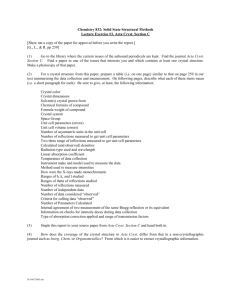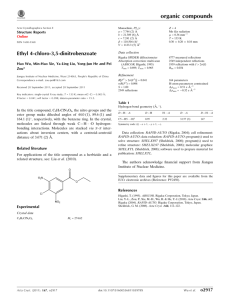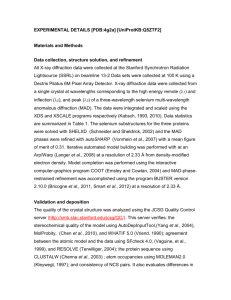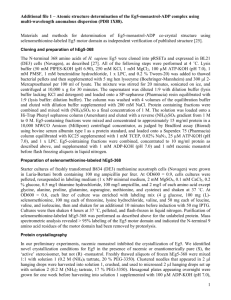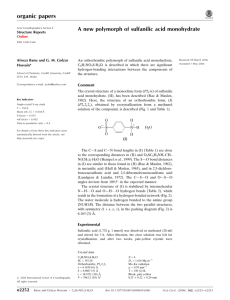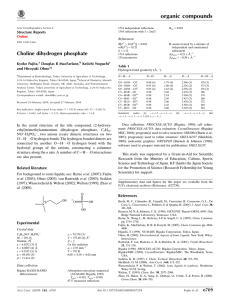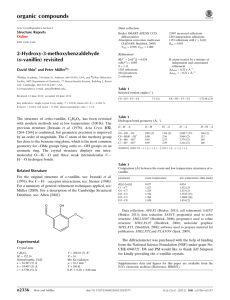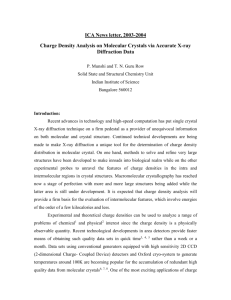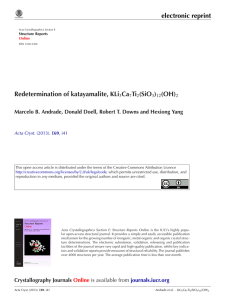Cobalt(II) orthophosphate octahydrate
advertisement
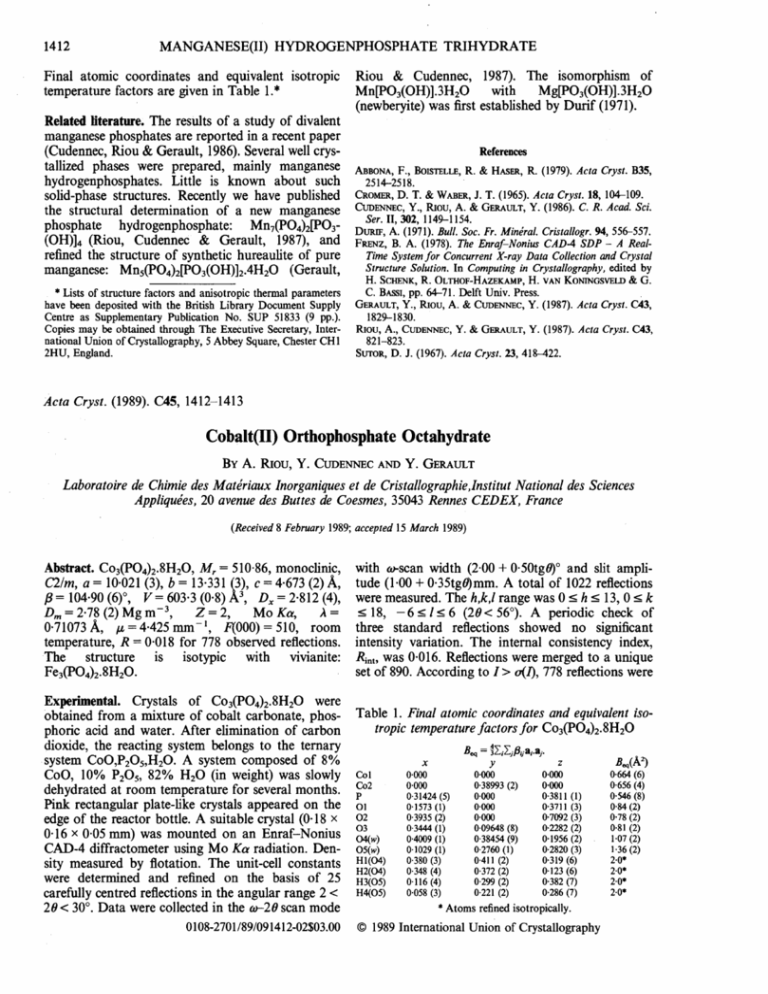
1412 MANGANESE(II) HYDROGENPHOSPHATE TRIHYDRATE Final atomic coordinates and equivalent isotropic temperature factors are given in Table 1.* Related literature, The results of a study of divalent manganese phosphates are reported in a recent paper (Cudennec, Riou & Gerault, 1986). Several well crystallized phases were prepared, mainly manganese hydrogenphosphates. Little is known about such solid-phase structures. Recently we have published the structural determination of a new manganese phosphate hydrogenphosphate: Mn70aO4)2[PO3(OH)]4 (Riou, Cudennec & Gerault, 1987), and refined the structure of synthetic hureaulite of pure manganese: Mns0aO4)2[POa(OH)]2.4H20 (Gerault, * Lists of structure factors and anisotropic thermal parameters have been deposited with the British Library Document Supply Centre as Supplementary Publication No. SUP 51833 (9 pp.). Copies may be obtained through The Executive Secretary, International Union of Crystallography, 5 Abbey Square, Chester CH1 2HU, England. Riou & Cudennec, 1987). The isomorphism of Mn[PO3(OH)].3H20 with Mg[PO3(OH)].3H20 (newberyite) was first established by Durif (1971). References ABBONA, F., BOISTELLE, R. & HAS~, R. (1979). Acta Cryst. B35, 2514-2518. CROMER, D. T. & WABER,J. T. (1965). Acta Cryst. 18, 104-109. C"trDENNEC,Y., Raou, A. & GV_~,LrLT,Y. (1986). C. R. Acad. Sci. Ser. II, 302, 1149-1154. DURIF, A. (1971). Bull. Soc. Fr. MindraL Cristallogr. 94, 556-557. FRENZ, B. A. (1978). The Enraf-Nonius CAD-4 SDP - A RealTime System for Concurrent X-ray Data Collection and Crystal Structure Solution. In Computing in Crystallography, edited by H. SCHENK, R. OLTHOF-HAZEKAMP,H. VAN KONINGSVELD& G. C. BASSI,pp. 64-71. Delft Univ. Press. GERAULT, Y., RIOU, A. & CUDEt,rNEC, Y. (1987). Acta Cryst. C43, 1829-1830. RIOU, A., CMDENNEC,Y. & GERAULT, Y. (1987). Acta Cryst. C43, 821-823. Strrog, D. J. (1967). Acta Cryst. 23, 418--422. Acta Cryst. (1989). C45, 1412-1413 CobaltOl) Orthophosphate Octahydrate BY A. PdOU, Y. CLrDE~¢EC AND Y. GERAULT Laboratoire de Chimie des Matdriaux Inorganiques et de Cristallographie,Institut National des Sciences Appliqudes, 20 avenue des Buttes de Coesmes, 35043 Rennes CEDEX, France (Received 8 February 1989; accepted 15 March 1989) Abstract. C o 3 ( P O 4 ) 2 . 8 H 2 0 , M r = 510"86, monoclinic, C2/m, a = 10.021 (3), b = 13-331 (3), c = 4-673 (2)/~, f l = 104.90 (6) °, V = 603.3 (0.8) A 3, Dx = 2-812 (4), Dm = 2"78 (2) Mg m -3, Z = 2, Mo Ka, A= 0.71073 A, /z = 4.425 m m - t , F(000) = 510, room temperature, R = 0.018 for 778 observed reflections. The structure is isotypic with vivianite: Fe3(POa)2.8H20. Experimental. Crystals of C o 3 ( P O 4 ) 2 . 8 H 2 0 w e r e obtained from a mixture of cobalt carbonate, phosphoric acid and water. After elimination of carbon dioxide, the reacting system belongs to the ternary system CoO,P2Os,H20. A system composed of 8% CoO, 10% P205, 82% H20 (in weight) was slowly dehydrated at room temperature for several months. Pink rectangular plate-like crystals appeared on the edge of the reactor bottle. A suitable crystal (0-18 x 0-16 x 0.05 mm) was mounted on an Enraf-Nonius CAD-4 diffractometer using Mo Ka radiation. Density measured by flotation. The unit-cell constants with to-scan width (2.00 + 0.50tgS) ° and slit amplitude (1.00 + 0-35tg0)mm. A total of 1022 reflections were measured. The h,k,l range was 0 ___h < 13, 0 ___k _< 18, - 6 < l < 6 (20< 56°). A periodic check of three standard reflections showed no significant intensity variation. The internal consistency index, Rint, was 0.016. Reflections were merged to a unique set of 890. According to I > o(/), 778 reflections were Table 1. Final atomic coordinates and equivalent isotropic temperature factors for C03(PO4)2.8H20 neq = 4~'q~..j ~ijfl i.aj , x Col Co2 P Ol 02 03 o4(w) 05(w) H1(O4) H2(O4) were determined and refined on the basis of 25 n3~o5) carefully centred reflections in the angular range 2 < 20 < 30 °. Data were collected in the a,-2O scan mode 0108-2701/89/091412-02503.00 I-I4~O5) 0.000 y 0-000 z 0.000 0.000 0-38993 (2) 0.000 0-31424 (5) 0.000 0-3811 (1) 0.1573 (I) 0-000 0-3711 (3) 0-3935 (2) 0.000 0"7092 (3) 0.3444 (1) 0"09648 (8) 0.2282 (2) 0.4009 (1) 0"38454(9) 0"1956 (2) 0-1029 (I) 0-2760 (1) 0.2820 (3) 0"380 (3) 0.411 (2) 0"319 (6) 0-348 (4) 0"372 (2) 0-123 (6) 0"116 (4) 0-299 (2) 0-382 (7) 0.058 (3) 0.221 (2) 0.286 (7) * Atoms refined isotropically. © 1989 International Union of Crystallography B~(A ~) 0-664(6) 0"656 (4) 0.546 (8) 0-84 (2) 0"78 (2) 0-81 (2) 1-07 (2) 1"36 (2) 2.0* 2"0* 2-0* 2-0* A. RIOU, Y. C U D E N N E C A N D Y. G E R A U L T regarded as observed. Data were corrected for Lorentz and polarization effects and absorption corrections were applied. The structural determination was carded out on a PDP 11/60 computer using the SDP package (Frenz, 1978). Scattering factors were from Cromer & Waber (1965). The structure was determined on the basis of isomorphism with Mg3(POa)2.8H20. Refinement was started with atomic coordinates reported by Tagaki, Mathew & Brown (1986). The four H atoms were refined isotropically. Full-matrix least-squares refinement was based on F and the function minimized was Y.w(IFol -IFcl) 2, where w(F) = 1/oe(F). The weighting scheme had a non-Poisson contribution with p = 0.050. Corrections were made for anomalous dispersion and secondary-extinction effects ( g = 3 . 6 x 10-7). During the last refinement cycle, the r.m.s. shift/e.s.d, was 0-39. The final difference Fourier map showed no features higher than 0.78 e A-3. In these conditions, the final R = 0-018 and wR = 0.026. Final atomic coordinates and equivalent isotropic temperature factors are given in Table 1.* * Lists of structure factors and anisotropic thermal parameters have been deposited with the British Library Document Supply Centre as Supplementary Publication No. SUP 51834 (7 pp.). Copies may be obtained through The Executive Secretary, International Union of Crystallography, 5 Abbey Square, Chester CH 1 2HU, England. 1413 Related literature. Little is known about cobalt phosphate hydrates. In a recent study (Cudennec, Lecerf, Riou & Gerault, 1987), we prepared crystals of Co3(PO4)2.8H20. This solid phase belongs to the large vivianite family: Mn(xoa)2.8H20 with M n = Fe, Co, Ni, Zn, Mg and XO4 = PO4, AsO4. The structure of vivianite: Fe3(PO4)2.8H20, was proposed by Mori & Ito (1950), without refinement of the atomic coordinates. More recently Hill (1979) has determined the structure of k6ttigite: Zn3(msOa)2.8H20, which was refined with the H atoms. Lastly, Tagaki et al. (1986) have determined the structure of Mg3(POa)2.8H20. References CROMEg, D. T. & WAaER, J. T. (1965). Acta Cryst. 18, 104-109. CUDENNEC,Y., LECEP,F, A., Raoo, A. & GERAULT,Y. (1987). Rev. Chim. Mindr. 24, 234-247. FRENZ, B. A. (1978). The Enraf-Nonius CAD-4 S D P - A RealTime System for Concurrent X-ray Data Collection and Crystal Structure Solution. In Computing in Crystallography, edited by H. Scrm~K, R. OLTHOF-HAZEKAMP,H. VAN KONINGSVELD• G. C. BASSI,pp. 64--71. Delft Univ. Press. HILL, R. J. (1979). Am. Mineral. 64, 376-382. MORI, H. & ITO, T. (1950). Acta Cryst. 3, 1-6. TAGAKI, S., MATHEW, M. & BROWN, W. E. (1986). Am. Mineral. 71, 1229-1233. Acta Cryst. (1989). C45, 1413-1415 Structure of Cs3MolsSel7 BY. P. GOUGEON, M. POTEL AND M. SERGENT Universitd de Rennes-Beaulieu, Laboratoire de Chimie Mindrale B, URA C N R S n ° 254, Avenue du Gdndral Leclerc, 35042 Rennes CEDEX, France (Received 16 April 1989; accepted 11 May 1989) Abstract. Caesium molybdenum selenide, Cs3Mo15 Sel7, Mr = 3180-14, hexagonal, P63/m, a = 9-624 (2), c=20"898(8) A, V =1676"4(7) A 3, Z = 2 , Dx= 6.276 g cm -3, A(Mo Ka) = 0-71073 A, /x = 266-5 c m - ~, F(000) = 2746, T = 293 K, R = 0.028 for 1028 reflections with I_> 20(/) and 58 parameters. The title compound is isostructural with Rb3Mo~sSel7 and thus its structure contains as the main building block the MolsSel7 cluster unit whose Mo core is built up by four face-sharing Mo 6 octahedra. Whereas the intracluster Mo---Mo distances as well as the Mo---Se ones are identical to within _0.01 A in both compounds, owing to the same cationic charge transfer towards the MolsSel7 unit, a slight lengthening of the intercluster Mo---Mo dis- 0108-2701/89/091413-03$03.00 tance from 3.268 to 3.318 A is observed, as expected, when the size of the cation increases. Experimental. Single crystals were obtained by heating a mixture of CsMo3Se3 and Mo3Se4 (3:2 ratio) in a sealed molybdenum crucible at about 2193 K for one hour and then cooling at 100 K h - l to 1273 K. Intensities were measured from a crystal fragment with dimensions 0-06 x 0-10 x 0.12 mm on an EnrafNonius CAD-4 diffractometer operating with graphite-monochromatized MoKcr radiation. Accurate cell parameters were obtained by a least-squares refinement of the setting angles of 25 reflections with 7-< 0_< 15°. 5366 reflections were recorded over the range 1 _< 0 _< 35 ° with h: - 15 ---,O, k: 0---, 15, l: 0--* © 1989 International Union of Crystallography
